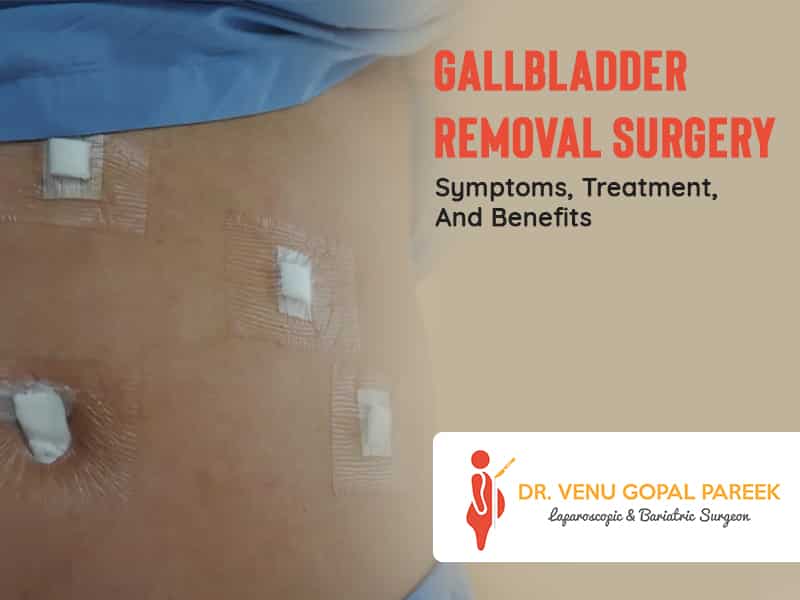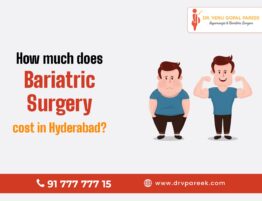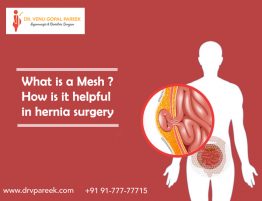
A Gallbladder is a small organ that resembles a pouch in appearance and located on the right side of your stomach. Its job is to store and release bile juice, which is produced by the liver and helps in digesting fats. The most common diseases attributed to the gallbladder are caused by excessive cholesterol or a liver pigment called bilirubin. This leads to:
- Gallstones
- Acute or chronic inflammation due to gallstones
- Bile duct stones
If symptoms become very uncomfortable, your doctor may recommend removing the gallbladder by open or laparoscopic method. Fortunately, you can still maintain a healthy life without the gallbladder. Surgical removal is relatively easy. In the absence of the gallbladder, bile juice will move directly from the liver to the intestine.
This blog from Dr Venu Gopal Pareek gives information about Gallstone symptoms, causes, types, benefits of surgical removal of the gallbladder.
Types of gallstones:

There are three types of gallstones:
- Cholesterol stones: Mainly composed of cholesterol, which is a fatty substance essential for metabolism. Cholesterol stones can become large enough to block the bile duct.
- Pigment stones: Mainly composed of bile juice. These stones are usually small but are large in number.
- Mixed stones: These are the most common type of stones, consisting of cholesterol and salt. Mixed stones tend to develop in large numbers.
What Causes Gallbladder Problems?

Gallstones mainly cause gallbladder problems. These stones can also enter the bile duct, which connects the gallbladder and the intestine. Gallstones can occur in the following conditions:-
- A woman
- Had children
- Overweight
- Over 40 years of age
What are the symptoms of Gallbladder Problems?
Gallstones often do not have symptoms, so you may not realize that you have them. However, sometimes, gallstones can block the flow of bile and irritate the gallbladder (acute cholecystitis) or pancreas (acute pancreatitis). Associated symptoms are:
- Sharp pain in your abdomen
- Nausea and vomiting
- Indigestion
- Fever
- Yellow skin: Jaundice is a medical term for yellowing of skin and eyes. You can get jaundice if gallstones block the bile duct.
Sometimes, tablets can dissolve gallstones, but surgical removal of the gallbladder is the most effective treatment. Usually, surgery gets done if you have severe pain.
How do doctors find gallbladder problems?
To diagnose gallbladder problems, the doctor will review your case history and conduct a abdominal examination. It includes analysis for abdominal pains.
Review of medical history
Listing to your symptoms is essential. A general health assessment can also get performed to determine whether there are signs of long-term gallbladder disease. These include:-
- Physical exam
- Ultrasound
- HIDA scan
- CT and MRI scan
- Endoscopic retrograde cholangiopancreatography (ERCP)
An ultrasound test shows the inside of the body with the help of sound waves. CT scan or HIDA scan are conducted if needed.HIDA scanning uses dye injection to show how well the bile ducts and gallbladder are working.
How do doctors treat gallbladder problems?

You may have heard about treatments for breaking gallstones or melting gallstones. Unfortunately, these are not ideal treatment options for some people. Gallbladder removal is often the best way to treat gallbladder probl ems. You can also get some relief if you change your diet. For example, eating food with less/low fat can help. However, gallstones rarely go away by themselves. Surgical removal of the gallbladder is called a cholecystectomy.
Let us see in detail about Cholecystectomy – Gallbladder removal surgery.
Pre-surgical Care before cholecystectomy:
Before surgery, there are several things that you should discuss with a doctor or surgeon, including:
- Your medical history, because some previous illnesses can influence surgical and anaesthetic decisions
- All medicines you regularly take, including over-the-counter medicines
- Before surgery, several preoperative examinations are needed, such as blood work, X-ray or EKG, and gallbladder ultrasound tests.
- Follow your surgeon’s instructions for all prescribed drugs.
What happens during surgery to remove the gallbladder?

There are two ways to remove the gallbladder. Both techniques performed under general anaesthesia, which means you are put to sleep during surgery so as not to feel pain during surgery.
Laparoscopic Gallbladder surgery: Some small incisions made on the abdomen, to access and remove the gallbladder doctor uses a fine surgical instrument.
Laparoscopic cholecystectomy Procedure:
- The surgeon makes small incisions on the abdomen so that a slender instrument reaches the abdominal cavity.
- A doctor inserts a tube with a stream of soft carbon dioxide. The tube separates the abdominal wall from the organs underneath.
- The surgeon observes the gallbladder on a television monitor with a mini-camera attached to the laparoscope.
- Special X-rays (cholangiograms) during surgery can check whether gallstones have entered the bile duct.
- The ducts and arteries that serve the gallbladder closed with a clip. These clips are permanent.
- The gallbladder is cut free with a laser or electrocautery.
- The gallbladder, along with gallstones, is pulled out of the body through one of the incisions on the stomach.
- Instruments and carbon dioxide gas removed after surgery from the abdominal cavity. Parts are sewn (closed) and covered with bandages.
Benefits of Laparoscopic Cholecystectomy:
- Patients usually have minimal postoperative pain.
- Faster recovery compared to those patients who have undergone open gallbladder surgery.
- Outstanding cosmetic results
- Minimal discomfort and early recovery
- Early resumption of regular and routine activities
Apart from the advantages of the laparoscopic approach, this procedure may not be suitable for some patients who have previously undergone upper abdominal surgery or who have certain medical conditions. If the gallbladder is very inflamed, infected, or has large gallstones or seems complex, doctors recommend open surgery.
Dr. Venu Gopal Pareek carefully reviews each patient’s case to determine the best type of procedure to do. However, in most cases, laparoscopic surgery is performed because you can leave the hospital early, recover faster, and have fewer scars compared to open procedures.

Open gallbladder surgery: Doctors make a larger incision on your stomach to access your gallbladder and then remove it.
Open gallbladder surgery Procedure: The general procedure is the same as a laparoscopic surgery, except that the surgeon reaches the gallbladder through a single large incision on the abdominal wall. Sometimes, an operation, which starts as a laparoscopic, may become open surgery when the surgeon has difficulty with visualizing the gallbladder.
Post-surgery Instructions after gallbladder surgery:
- The patient is put under observation for several hours and then shifted to a room.
- The patient is allowed to drink oral fluids on the same day of surgery.
- Patients are allowed to move independently as soon as possible after surgery.
- Usually, depending on the clinical condition, the patient is discharged on the same day or the next day of surgery.
- You have had to stay for a day in the hospital if you have a laparoscopic cholecystectomy
- You may have to stay in the hospital for up to two days after undergoing open surgery.
- At the incision site, a waterproof bandage is applied, and patients can shower if necessary, as suggested by the treating doctor. Care to be exercised not to get the dressing wet.
- Patients get advised to revisit five days post-op. After discharge, a discharge summary recommending drugs given along with a date for a follow-up appointment.
Self-care after gallbladder surgery:
Your treating doctor shall guide you regarding self-care after surgery. However, general self-care advice includes:
- Rest as much as possible for three to five days.
- Avoid exercise and lifting heavyweights.
- Expect your digestive system to take several days to return to normal function. Flatulence, abdominal pain, and change in urination habits are common short-term problems.
Recovery from gallbladder surgery:
- It usually doesn’t take long for you to recover from keyhole gallbladder removal surgery.
- Most people can leave the hospital the same day or the next day. You may be able to get back to most of your normal activities within two weeks.
- Recovery from open surgery takes a bit longer. You may need to stay in the hospital for 3 to 5 days, and it may take 6 to 8 weeks for you to resume your day-to-day activities.
Life without a gallbladder:

- Even without a gallbladder, you can completely live a normal life.
- Your liver will continue to produce enough bile to digest food, but instead of storing it in the gallbladder, the liver is constantly dripping bile into your digestive system.
- Before the surgery, you may be advised to go on a special diet. But it doesn’t need to be continued after surgery.
- Instead, you should try to maintain a healthy and balanced diet overall.
- Although some people have problems such as bloating of stomach or diarrhoea after surgery, this usually improves within a few weeks.
- If you find that certain foods or drinks are causing these symptoms, refraining from them is suggested.
Conclusion:
Gallbladder removal is a relatively common and safe procedure, but there are always some side effects. Knowing how to identify and reduce symptoms, side effects, and complications before and after surgery can help you. You need to visit your doctor between seven and ten days after surgery to make sure everything is okay.
The risk of complications from open gallbladder surgery is low. However, some symptoms can indicate infection. Contact a doctor if you experience any new problems. Patients need to follow their treating doctor’s instructions after surgery. Awareness of infection, symptoms, or other complications can help a person start treatment quickly to reduce side effects.
For further information regarding gallbladder removal surgery and the best treatment options, please schedule an appointment with Dr Venu Gopal Pareek at +91 91-777-77715.







